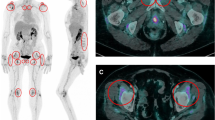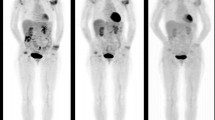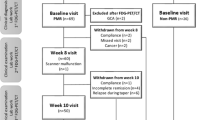Abstract
Purpose
To evaluate the use of 18F-FDG PET/CT for the assessment of tocilizumab (TCZ) as first-line treatment in patients with polymyalgia rheumatica (PMR).
Methods
Patients with PMR were prospectively enrolled in a multicentre clinical trial assessing TCZ therapy (the TENOR trial). The patients underwent FDG PET/CT at baseline, after the first infusion of TCZ (TCZ 1) and after the last infusion of TCZ (TCZ 3). Responses to treatment were evaluated in terms of the PMR activity score (PMR-AS), and the C-reactive protein (CRP) and erythrocyte sedimentation rate (ESR) laboratory tests. Maximal standardized uptake value (SUVmax) was used for assessment of FDG uptake in regions usually affected in PMR (spinous processes, hips, shoulders, sternoclavicular region and ischial tuberosities). The Wilcoxon test was applied to evaluate the changes in parameters after the infusions and Spearman’s rank correlation test was applied to assess the correlations between SUVmax and PMR-AS, CRP and ESR.
Results
Of 21 patients included in the trial, 18 were evaluated. The median bioclinical parameter values decreased after TCZ 1 (PMR-AS from 38.2 to 15.7, CRP from 65.2 to 0.4 mg/l and ESR from 49 to 6.5 mm; all p < 0.05) as did the median SUVmax (from 5.8 to 5.2; p < 0.05). All values also decreased after TCZ 3 (PMR-AS from 38.2 to 3.9, CRP from 65.2 to 0.2, ESR from 49 to 2, and SUVmax from 5.8 to 4.7; p < 0.05). In a region-based analysis, all SUVmax were significantly reduced after TCZ 3, except the values for the cervical spinous processes and shoulder regions. With regard to correlations, few significant differences were found between ∆SUVmax and the other parameters including ∆PMR-AS, ∆CRP and ∆ESR in the patient-based and region-based analysis.
Conclusion
FDG uptake decreased significantly but moderately after TCZ therapy in PMR patients, and might reflect disease activity.


Similar content being viewed by others
References
Mori S, Koga Y. Glucocorticoid-resistant polymyalgia rheumatica: pretreatment characteristics and tocilizumab therapy. Clin Rheumatol. 2014. doi:10.1007/s10067-014-2650-y.
Devauchelle V, Saraux A, Youinou P, Le Goff P. Prevalence of synovitis in patients with polymyalgia rheumatica and/or giant cell arteritis. Rev Rhum Engl Ed. 1997;64:594–5.
Chuang TY, Hunder GG, Ilstrup DM, Kurland LT. Polymyalgia rheumatica: a 10 years epidemiologic and clinical study. Ann Intern Med. 1982;97:672–80.
Salvarani C, Macchioni P, Manzini C, Paolazzi G, Trotta A, Manganelli P, et al. Infliximab plus prednisone or placebo plus prednisone for the initial treatment of polymyalgia rheumatica: a randomized trial. Ann Intern Med. 2007;146:631–9.
Hoffman GS, Cid MC, Rendt-Zagar KE, Merkel PA, Weyand CM, Stone JH, et al. Infliximab for maintenance of glucocorticosteroid-induced remission of giant cell arteritis: a randomized trial. Ann Intern Med. 2007;146:621–30.
Hernandez-Rodriguez J, Cid MC, Lopez-Soto A, Espigol-Frigole G, Bosch X. Treatment of polymyalgia rheumatica: a systematic review. Arch Intern Med. 2009;169:1839–50.
Devauchelle-Pensec V, Jousse S, Destombe C, Saraux A. Epidemiology, imaging, and treatment of giant cell arteritis. Joint Bone Spine. 2008;75(3):267–72.
Caporali R, Cimmino MA, Ferraccioli G, Gerli R, Klersy C, Salvarani C, et al. Prednisone plus methotrexate for polymyalgia rheumatica: a randomized, double-blind, placebo-controlled trial. Ann Intern Med. 2004;141:493–500.
Alvarez-Rodriguez L, Lopez-Hoyos M, Mata C, Marin MJ, Calvo-Alen J, Blanco R, et al. Circulating cytokines in active polymyalgia rheumatica. Ann Rheum Dis. 2010;69:263–9.
Hagihara K, Kawase I, Tanaka T, Kishimoto T. Tocilizumab ameliorates clinical symptoms in polymyalgia rheumatica. J Rheumatol. 2010;37:1075–6.
Loricera J, Blanco R, Castaneda S, Humbría A, Ortego-Centeno N, Narváez J, et al. Tocilizumab in refractory aortitis: study on 16 patients and literature review. Clin Exp Rheumatol. 2014;32(3 Suppl 82):S79–89.
Leeb BF, Bird HA. A disease activity score for polymyalgia rheumatica. Ann Rheum Dis. 2004;63:1279–83.
Cleuziou C, Binard A, De Bandt M, Berthelot JM, Saraux A. Contribution of the polymyalgia rheumatica activity score to glucocorticoid dosage adjustment in everyday practice. J Rheumatol. 2012;39:310–3.
Barrington SF, Mikhaeel NG, Kostakoglu L, Meignan M, Hutchings M, Müeller SP, et al. Role of imaging in the staging and response assessment of lymphoma: consensus of the International Conference on Malignant Lymphomas Imaging Working Group. J Clin Oncol. 2014;32:3048–58.
Weber WA, Wieder H. Monitoring chemotherapy and radiotherapy of solid tumors. Eur J Nucl Med Mol Imaging. 2006;33:27–37.
Nanni C, Boriani L, Salvadori C, Zamparini E, Rorato G, Ambrosini V, et al. FDG PET/CT is useful for the interim evaluation of response to therapy in patients affected by haematogenous spondylodiscitis. Eur J Nucl Med Mol Imaging. 2012;39:1538–44.
Guleria R, Jyothidasan A, Madan K, Mohan A, Kumar R, Bhalla AS, et al. Utility of FDG-PET-CT scanning in assessing the extent of disease activity and response to treatment in sarcoidosis. Lung India. 2014;31:323–30.
Yamashita H, Kubota K, Mimori A. Clinical value of whole-body PET/CT in patients with active rheumatic diseases. Arthritis Res Ther. 2014;16:423.
Blockmans D, Stroobants S, Maes A, Mortelmans L. Positron emission tomography in giant cell arteritis and polymyalgia rheumatica: evidence for inflammation of the aortic arch. Am J Med. 2000;108:246–9.
Blockmans D, De Ceuninck L, Vanderschueren S, Knockaert D, Mortelmans L, Bobbaers H. Repetitive 18-fluorodeoxyglucose positron emission tomography in isolated polymyalgia rheumatica: a prospective study in 35 patients. Rheumatology (Oxford). 2007;46:672–7.
Kotani T, Komori T, Kanzaki Y, Takeuchi T, Wakura D, Iimori A, et al. FDG-PET/CT of polymyalgia rheumatica. Mod Rheumatol. 2011;21:334–6.
Yamashita H, Kubota K, Takahashi Y, Minamimoto R, Morooka M, Kaneko H, et al. Similarities and differences in fluorodeoxyglucose positron emission tomography/computed tomography findings in spondyloarthropathy, polymyalgia rheumatica and rheumatoid arthritis. Joint Bone Spine. 2013;80:171–7.
Yamashita H, Kubota K, Takahashi Y, Minaminoto R, Morooka M, Ito K, et al. Whole-body fluorodeoxyglucose positron emission tomography/computed tomography in patients with active polymyalgia rheumatica: evidence for distinctive bursitis and large-vessel vasculitis. Mod Rheumatol. 2012;22:705–11.
Toriihara A, Seto Y, Yoshida K, Umehara I, Nakagawa T, Liu R, et al. F-18 FDG PET/CT of polymyalgia rheumatica. Clin Nucl Med. 2009;34:305–6.
Besson FL, Parienti JJ, Bienvenu B, Prior JO, Costo S, Bouvard G, et al. Diagnostic performance of 18F-fluorodeoxyglucose positron emission tomography in giant cell arteritis: a systematic review and meta-analysis. Eur J Nucl Med Mol Imaging. 2011;38:1764–72.
Al Rashidi A, Hegazi MO, Mohammad SA, Varghese A. Effective control of polymyalgia rheumatica with tocilizumab. J Clin Rheumatol. 2013;19:400–1.
Macchioni P, Boiardi L, Catanoso M, Pulsatelli L, Pipitone N, Meliconi R, et al. Tocilizumab for polymyalgia rheumatica: report of two cases and review of the literature. Semin Arthritis Rheum. 2013;43:113–8.
Okamura K, Yonemoto Y, Arisaka Y, Takeuchi K, Kobayashi T, Oriuchi N, et al. The assessment of biologic treatment in patients with rheumatoid arthritis using FDG-PET/CT. Rheumatology (Oxford). 2012;51:1484–91.
Brown AK, Conaghan PG, Karim Z, Quinn MA, Ikeda K, Peterfy CG, et al. An explanation for the apparent dissociation between clinical remission and continued structural deterioration in rheumatoid arthritis. Arthritis Rheum. 2008;58:2958–67.
Kanstrup IL, Klausen TL, Bojsen-Møller J, Magnusson P, Zerahn B. Variability and reproducibility of hepatic FDG uptake measured as SUV as well as tissue-to-blood background ratio using positron emission tomography in healthy humans. Clin Physiol Funct Imaging. 2009;29(2):108–13.
Author information
Authors and Affiliations
Corresponding author
Ethics declarations
Funding
Roche-Chugai provided an unconditional grant for the study. Tocilizumab was donated free of charge by Roche-Chugai. Roche-Chugai had no role in the design or conduct of the study, or the management of the collection, analysis or interpretation of the data, or in the preparation, revision or approval of the manuscript.
Conflicts of interest
None.
Ethical approval
All procedures performed in studies involving human participants were in accordance with the ethical standards of the institutional and/or national research committee and with the principles of the 1964 Declaration of Helsinki and its later amendments or comparable ethical standards.
Informed consent
Written informed consent was obtained from all individual participants included in the study.
Rights and permissions
About this article
Cite this article
Palard-Novello, X., Querellou, S., Gouillou, M. et al. Value of 18F-FDG PET/CT for therapeutic assessment of patients with polymyalgia rheumatica receiving tocilizumab as first-line treatment. Eur J Nucl Med Mol Imaging 43, 773–779 (2016). https://doi.org/10.1007/s00259-015-3287-z
Received:
Accepted:
Published:
Issue Date:
DOI: https://doi.org/10.1007/s00259-015-3287-z




